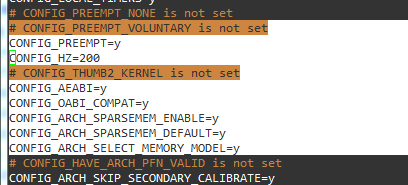一、Linux定时器基础知识
1.1 定时器的使用范围
延后执行某个操作,定时查询某个状态;前提是对时间要求不高的地方
1.2 内核时间概念
- Hz:(系统时钟通过CONFIG_HZ来设置,范围是100-1000;HZ决定使用中断发生的频率)

-
- 1/200 = 5ms,说明4412中是5ms产生一次时钟中断。如果就没有定义的话,默认是100
- 内核的全局变量jiffies:(记录内核自启动来的节拍数,内核之启动以来,产生的中断数)时钟中断,每产生一个中断,jiffies就加1。
- jiffies/HZ:jiffies除以Hz得到内核自启动以来的秒数
2.1 内核定时器的例程
结构体timer_list,函数setup_timer,add_timer,del_timer,mod_timer

struct timer_list { /* * All fields that change during normal runtime grouped to the * same cacheline */ struct list_head entry; unsigned long expires; struct tvec_base *base; void (*function)(unsigned long); unsigned long data; int slack; #ifdef CONFIG_TIMER_STATS int start_pid; void *start_site; char start_comm[16]; #endif #ifdef CONFIG_LOCKDEP struct lockdep_map lockdep_map; #endif };
timer_list参数
- struct list_head entry双向链表
- unsigned long expires:超时时间,记录什么时候产生时钟中断
- struct tvec_base *base:管理时钟的结构体
- void *(function)(unsigned long):时钟中断产生之后的动作
- unsigned long data:传递的参数
#define setup_timer(timer, fn, data) do { static struct lock_class_key __key; setup_timer_key((timer), #timer, &__key, (fn), (data)); } while (0) void add_timer(struct timer_list *timer); int del_timer(struct timer_list * timer); int mod_timer(struct timer_list *timer, unsigned long expires);
2.2 双向链表
platform_driver_register→driver_register
→bus_add_driver
→struct bus_type *bus
→struct subsys_private *p
→struct kset subsys→struct list_head list;
2.3 mod_timer相当于
mod_timer = del_timer(time);timer->expires = expires;add_timer(timer);
3 内核定时器实现的分析
从内核定时器初始化到定时器例程
3.1 add_timer如何添加定时器
add_timer→mod_timer
→__mod_timer(内核函数有下划线,表示“局部函数”)
→internal_add_timer
3.2 struct tvec_base *base结构体分析--管理内核时钟的结构体
struct tvec_base { spinlock_t lock; //自旋锁 struct timer_list *running_timer; //内核中正在处理的定时器 unsigned long timer_jiffies; //内核目前正在处理的定时器时间 unsigned long next_timer; struct tvec_root tv1; { struct list_head vec[TVR_SIZE];//256长度数组 TVR_SIZE→#define TVR_SIZE (1 << TVR_BITS) TVR_BITS=8; 宏定义CONFIG_BASE_SMALL=0 TVR_SIZE = 256 } struct tvec tv2; //64长度数组 struct tvec tv3; struct tvec tv4; struct tvec tv5; }
per_cpu 与CPU核多少有关
DEFINE_PER_CPU看到这样的变量,就表明这个变量是和CPU核相关的。
有一些宏定义是在内核目录的config文件配置的
3.3 internal_add_timer
分析idx参数
如果idx<256,则将time_list添加到TV1
如果idx<256*64,则将time_list添加到TV2
如果idx<256*64*64,则将time_list添加到TV3
如果idx<256*64*64*64,则将time_list添加到TV4
如果idx > 0xffffffffUL,则将time_list添加到TV5
3.4 list_add_tail
双向链表操作函数都在include/linux/list.h文件中
